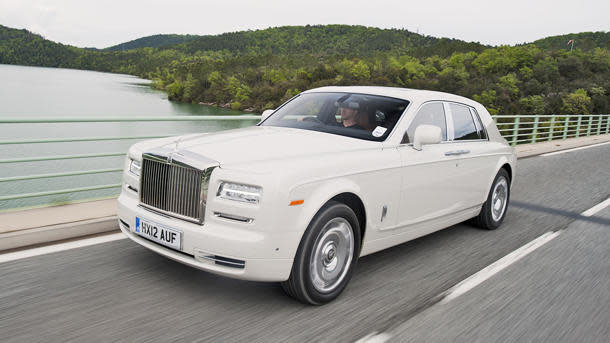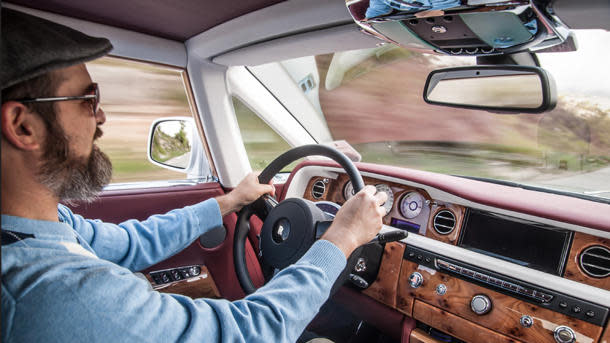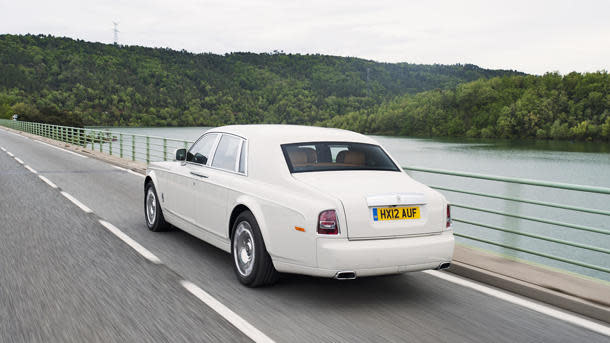 Motoramic
MotoramicRolls-Royce Phantom Series II: Motoramic Drives
"This is a long way to come for a new set of headlights," said a fellow writer as we got into our chauffeur-driven Rolls-Royce at the airport in Nice, France. "Oh, no," our driver pointed out, helpfully and probably by design, "there is much more to the Phantom."
All the real heavy lifting for this archduke's plaything occurred in the late '90s and early aughts, after BMW purchased Rolls-Royce, a once-great British label that had gathered as many cobwebs as Miss Havisham's wedding dress. The German masters imagineered the Rolls for a new generation of globe-hopping aristocracy, one that likes to drive with the power of a V-12 direct-injection engine while also surrounded by a lacquered forest of walnut veneer and a panoply of "bespoke" luxury items. The new Phantom was a 5,600-pound car that went 60 mph in under six seconds, with brakes that could crush coal into diamonds. Everyone loved driving it, but the car's design got Rolls in trouble. The Phantom was 19 feet long, with a hood the breadth of a football pitch. One critic compared it to a coffin. Another, "the world's most majestic air conditioner."
BMW's Rolls took these criticisms and spent the next decade swatting them away. In 2007 came the Phantom Drophead Coupé, a multi-platinum ragtop that condensed the original Phantom without sacrificing one foot-pound of torque, followed by a hard-topped grand-touring Coupé. The Spirit Of Ecstasy perched on the hood still indicated "none shall pass," but at least the Phantom had loosened up a bit, like Peter Boyle learning how to sing "Puttin' On The Ritz." Soon Rolls debuted its Ghost series, which was half the price of the Phantom, for people who enjoy the luxury and power of a Rolls but don't want to feel like they're chauffeuring a dowager countess to a royal funeral.
Now the Phantom has been massaged enough to be deemed Series II, snootier than ever, with prices exceeding half a million. In addition to an LED headlight system that changes direction as the road curves and could spot a sniper in the hills at a thousand meters, the Series II brings an eight-speed gearbox, a modern navigation screen featuring a 3D topographic map and surround-look camera systems. There's also a list of minor cosmetic updates as long as a private-dining room wine list.
But these are trifling accessories in the overall. The Rolls-Royce Phantom Series II is still essentially the same grandiloquent luxury barge that debuted nearly a decade ago. As an executive said during our mercifully short press briefing, "they got it right in 2003. Rolls-Royce doesn't do facelifts." In other words, let them eat cake.
During my high-end Rolls weekend in the South Of France, there was plenty of cake to go around.
Rolls likes to describe its brand as an avatar of "effortless luxury." To illustrate this, they treated a non-elite gaggle of car hacks to a weekend that included a wake-jumping ride in a $1.5 million Swedish-designed luxury powerboat, evenings full of unlimited after-dinner drinks, and a dinner at a Phillippe Starck-designed restaurant adjacent to Monaco Harbor. We stayed at Le Cap Estel, an elite private compound with fewer than 30 rooms, all marble flooring and soaring balustrades and top-end Cote d'Azur style. It boasts a cliffline of Mediterranean coast that would make Brigitte Bardot drool. Princess Grace used to send overflow guests when the Monaco palace was full. Discretion is the watchword there. As a Rolls guy said to us, "it's a place where celebrities can come and wear baggy clothes."
One morning I got to spend a few minutes in one of Le Cap Estel's seemingly endless series of lounges with Torsten Müller-Otvos, Rolls-Royce's CEO. A debonair gentleman in his mid-40s with a full shock of slick gray hair and nifty white suede arm patches on his sports coat, Müller-Otvos was not to the manor born. He told me that he was always a "big car nut," his interest springing from boyhood hours in a friend's garage, where they "pulled his old Beetle to bits." After many years in the BMW sales and marketing departments, he made his name by successfully relaunching the Mini around the same time BMW resurrecting Rolls. This taught him, he says, that "authenticity in a car brand is important. A brand needs to be aligned with its genes."
When I asked Müller-Otvos what his competition was, he said, "Helicopters. Jewelry. Art. Motor yachts. Sailing boats. A chalet in the Swiss Alps. No one thinks of a Rolls when their lease expires and they're wondering what sort of car they should buy. This isn't the sort of business we're in. We are in the luxury goods business. Rolls-Royce is used as a synonym for the best money can buy."
With that, it was time to motor.
A half-dozen Phantoms sat in the driveway of Le Cap Estel, polished to the inch. My drive partner for the day, a dapper 60-year-old Egyptian named Adel Murad, was eyeing a bone-white Coupé as though it were a model under an umbrella at a San Tropez beach resort.
"Let's take this one," he said. "It is the fashion this year."
But of course, I thought.
Adel took first crack behind the wheel. I sank into my burgundy-red hand-stitched leather chair, removed my shoes, and let my feet lose themselves in the plush lambswool carpet. Wood grain surrounded me. Above, the ceiling twinkled with dozens of little LED lights that had been hand-woven into the fabric. This was Rolls' famous "starlight headliner," put there as if to say, you not only own the roads when you're in this car, you also own the sky.
After a half hour, Adel handed over the reigns. This wasn't his first Rolls rodeo and he didn't need that much wheel time. In the world's most pricey Chinese fire drill, we switched in the parking lot of a gas station. My first impression was of the steering wheel, how thin, solid, and elegant it was compared with the puffed bratwursts in most contemporary cars. This, Rolls' press materials told us, is "reminiscent of elegantly engineered multifunction helms" from classic cars in the 1930s. Now under my command, the car glided away.
The seat was so low, I could barely see over the Coupé's front end. I actually had to crane my head slightly. But that didn't seem to matter. The car handled so intuitively, with such grace and power, that the scenery seemed to melt away in front of me. I'd always wondered what it was like to drive a car like this, and now I knew: Easy. The Rolls felt incredibly nimble, which surprised me considering it was as long as a city block. It floated like some sort of swan's head pontoon boat on a meandering canal. This, Adel told me, was by design. "People in this class," he said, "are never in a hurry."
The car was so big and the roads so tiny that we couldn't really fit into one lane. Backing it up, Adel later said, was like "turning around an oil tanker." But it also had enough power to tow an ocean liner, and showed its strength at every opportunity. When we hit the hills and needed the brakes and steering, both were responsive as a trusted butler.
Soon after, we drove through a village. A group of Frenchmen, busy getting drunk tableside, jeered at us and made obscene gestures as we maneuvered past them in our bone-white whale. "The French hate this car," one of the photographers told me later. "Their idea of a luxury car is old, small, and kind of rusty."
That's one of the best things about these European drives. You get to see ancient national hatreds play out in full.
After a leisurely lunch where we ate asparagus and sea bream and an elderly Frenchman played "The Yellow Rose Of Texas" on an accordion, Adel and I took the Saloon for a spin. I sat in the back, a recommended posture in the Saloon since they elevate the back 18 mm to allow for an "inspirational view." I drew the curtains closed on the side windows, removed my shoes again, turned on the starlight headliner, and breathed in rich flutes of leather.
"Ahh," I sighed.
"Even the Queen of England couldn't do any better than this," Adel said.
The road down to the coast was curvy. Adel drove very fast. I began to moan. The Rolls is famous for "waftability," a tight suspension that gives you the feeling of being rocked from side-to-side, as if on a sailboat. This works great if you're taking the princes on a seaside holiday or waving at people in a parade. But if you're horribly jet-lagged and have too much rich food, wine, and coffee in your system, something else starts to waft.
A holiday camper clogged the lane in front of us. Adel grunted and whipped the car around it. At that moment, my guts looped upward.
I'll always remember aggressively vomiting up my lunch while standing in my socks by the side of the road in the south of France. Fleetwood Mac's "Rumors" belted out of the Saloon's Harmon sound system. How I hate that album. Adel looked on, concerned.
"It's better in the front, I think," he said.
Later, my constitution vaguely restored, I drove the Saloon for an hour-and-a-half on the way back to Le Cap Estel. The Phantom isn't meant for twisty roads, unless it's being driven by a villain who really needs to escape to his secret mountain fortress. But on the motorway, it's the most magnificent conveyance ever created by humans. Despite repeated warnings that the French motor cops were champing at the bit to give us tickets, I jacked it up to 95 mph without a thought. The scenery passed as though it were moving and the car standing still. At that moment, I felt -- inappropriately, since they were going to take the car away from me 15 minutes later and never let me touch one again -- like the ruler of the world.

 Yahoo Autos
Yahoo Autos 



